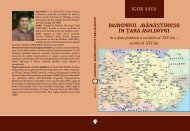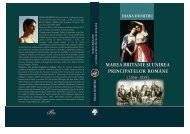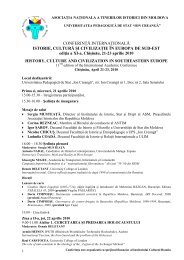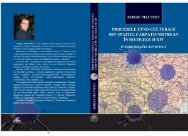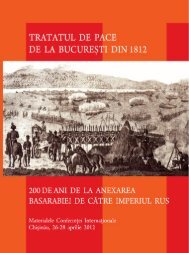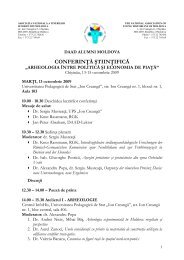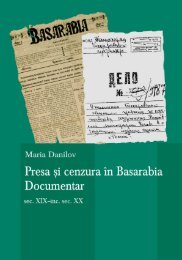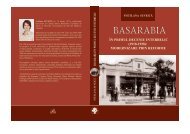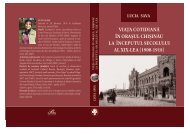Publicatie cu continut integral - Asociatia Tinerilor Istorici din Moldova
Publicatie cu continut integral - Asociatia Tinerilor Istorici din Moldova
Publicatie cu continut integral - Asociatia Tinerilor Istorici din Moldova
Create successful ePaper yourself
Turn your PDF publications into a flip-book with our unique Google optimized e-Paper software.
of the 1990s Latgalian Renaissance took place and local intellectuals tried to imagine Latgale as their lieux de<br />
memoir. But they were not alone: Latgale figurated in historical concepts of neighboring nations. Russian, Polish<br />
and Belarus intellectuals preferred to see in history of Latgale part of their national histories.<br />
For Russian nationalists Baltic lands in general were Russian lands 1 and Latgale, in parti<strong>cu</strong>lar, was part of<br />
Vitebskaia guberniia populated by Latvians, which were understandable as only tribe from numerous inorodtsy<br />
ethnical groups. In such context Latgalian medieval history was understandable as history of Russian periphery.<br />
For national orientated Belarus intellectuals Latgale is also not Latvian land, but part of Belarus Vitsebshchina<br />
only. Among Polish intellectuals were politicians who preferred to see in Latgale only inflanty Polskie - one of<br />
Polish regions, integrated to Polish Medieval history in general. So, different concepts of Latgale as lieux de memoir<br />
appeared in national historiographies.<br />
These narratives can be analyzed in categories of history writing, imagined communities and nationalism studies.<br />
I understand that contemporary history writing develop under influence of post-modernism paradigm 2 . That<br />
is why my concepts can be far from real events how they were in the past. But I think that different perceptions of<br />
Latgale can be studied and they can be also useful for understan<strong>din</strong>g of those processes which created for us Latvia<br />
as we know it. As for perception of Latgale in Belarus and Latvian-Latgalian historical memories, this aspect<br />
is not so well studied. That is why my paper will be devoted to development of Latgalian images in these three<br />
traditions. Analysis of Latgale as lieux de memoir in these national historiographical narratives will be useful for<br />
understan<strong>din</strong>g of Baltic Europe as part of Central Europe and part of the Greater Europe. It will be also especially<br />
useful for studies of European identities in Baltic Region.<br />
Russian historiography traditionally developed as Imperial narrative. Vasilii Tatischev and nikolai Karamzin<br />
were the first Russian nationalists who did a lot for formation and development of this official narrative. Later<br />
other Russian historians also, mainly Sergei Solov’iov and Vasilii Kliuchevskii, but also natal’ia ishimova in her<br />
popular books in Russian history, developed the same ideas. They preferred to write history of Russia as history<br />
of Russia. Some of them also declared thesis that it would be useful and interesting analyze how life of Russian<br />
people changed in historical perspective.<br />
That is why Russian historians and Russian intellectuals, engaged in history studies, positioned themselves<br />
not only as Russian historians, as historians of Russian tsars an Empire, but also as historians of Russians. In such<br />
situation they widely used words like russkii narod or velikorusskaia narodnost’. In fact we’ll be able too find a<br />
little about or<strong>din</strong>ary Russians, but a lot – about Russian tsars, kings, boyars. So, Russians were not main heroes<br />
of official historical concepts which dominated in Russian historiography. In the same time Russian intellectual<br />
spoke and wrote in Russian and they tried to underline the fact that they also belonged to Russian nation. On another<br />
hand it was obvious for them that in Russian Empire lived not only Russians.<br />
As for nations of Slavic origin Russian intellectual were nationalistic orientated and they preferred to ignore<br />
existence of separate Ukrainian and Belarus nations – Russian nationalists wrote about malorossy and belorussy<br />
as about ethnographical Russian groups only. In Poland it was more diffi<strong>cu</strong>lt for them ignore numerous fact of<br />
Polish identity which was radically opposite and different to Russian one. In this region Russian administration<br />
experimented with different forms and methods of Rusification of local Polish-speaking peasants who were<br />
Catholics also.<br />
But among European non-Russian regions Baltic one was the most interesting. It belonged to the number of<br />
territories which were oc<strong>cu</strong>pied by Russia when it had become Empire already. And, being Empire, Russia tried<br />
to use in the same time local pre-Russian, mainly German and Polish, political institutions and traditional Russian<br />
methods of political oppression. Russian officials were very rare in Baltic territories which were under German<br />
control. Russian politicians in Saint-Petersburg presumed that their German friends would be able to control Estonian<br />
and Latvian peasants. In the same time they did not used these names for local peasants, but otherness of<br />
local population was obvious fact 3 . For them they were just peasants – sometimes Russian nationalistic orientated<br />
intellectuals called Estonians сontemptuously chukhontsy and Latvians were for them lifliandskie or kurliandskie<br />
krest’iane only.<br />
1 PSHENICHNIKOV, 1910.<br />
2 PIDHAETS’KYI, 2000.<br />
3 SHKANDRIJ, 2001, 2004.<br />
– 0 –



